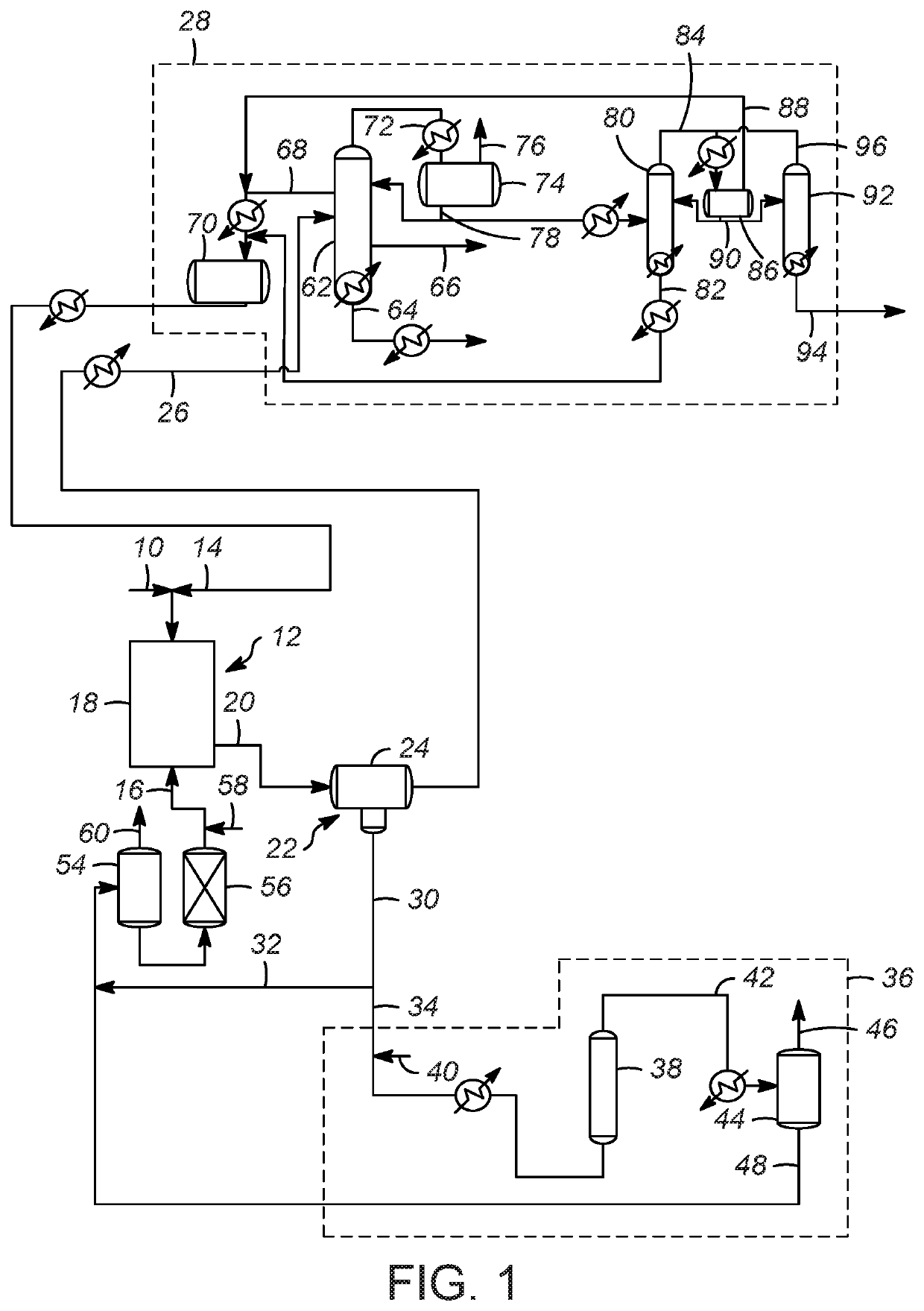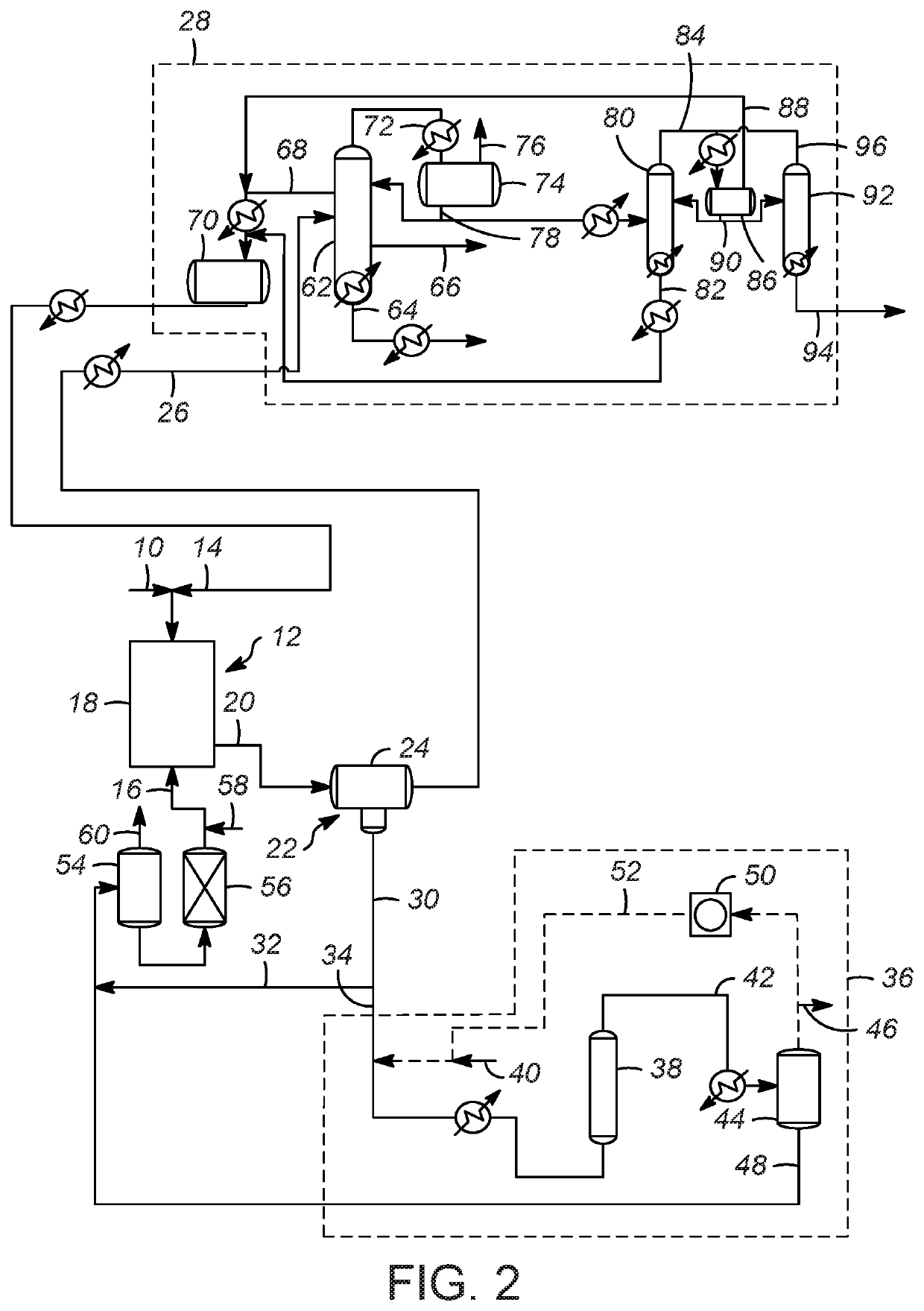Ionic liquid catalyst regeneration
- Summary
- Abstract
- Description
- Claims
- Application Information
AI Technical Summary
Benefits of technology
Problems solved by technology
Method used
Image
Examples
example 1
uid Catalyst Comprising Anhydrous Metal Halide
[0070]Various ionic liquid catalysts made of metal halides such as AlCl3, AlBr3, GaCl3, GaBr3, InCl3, and InBr3 could be used for the catalytic processes. N-butylpyridinium chloroaluminate (C5H5NC4H9Al2Cl7) ionic liquid catalyst is an example used in the present processes. The ionic liquid catalyst has the following composition:
[0071]Al 12.4 (wt. %)
[0072]Cl 56.5 (wt. %)
[0073]C 24.6 (wt. %)
[0074]H 3.2 (wt. %)
[0075]N 3.3 (wt. %)
example 2
n of C4 Olefin and Isobutane to Produce Alkylate Gasoline
[0076]Evaluation of C4 olefins alkylation with isobutane was performed in a continuously stirred tank reactor using typical refinery mixed C4 olefin feed and isobutane. A 10:1 molar mixture of isobutane and olefin was fed to the reactor while vigorously stirring. An ionic liquid catalyst was fed to the reactor via a second inlet port targeting to occupy 5-6 vol % in the reactor. A small amount of n-butyl chloride was added to produce anhydrous HCl gas. The average residence time (combined volume of feeds and catalyst) was about 5 minutes. The outlet pressure was maintained at approximately 1380 kPa (200 psig) and the reactor temperature was maintained at 35° C. (95° F.) using external cooling.
[0077]The reactor effluent was separated with a gravity separator and then through a coalescer into a hydrocarbon phase and an ionic liquid catalyst phase. The hydrocarbon stream was further separated into multiple streams: a C3 stream co...
example 3
ion of Ionic Liquid Catalyst with Hydrogen Gas
[0078]The spent ionic liquid catalyst was sent to an on-line regeneration unit operated at 176.7° C. (350° F.) and 5,516 kPa (800 psig) and 0.15 LHSV without any solid regeneration catalyst. The hydrogen flow was varied in the range of 520 to 2,200 SCF H2 / BBL ionic liquid to examine the performance of the regeneration process as a function of hydrogen gas flow. To facilitate intimate contact between the spent ionic liquid catalyst with hydrogen gas, a bubble column reactor described in U.S. Pat. No. 9,802,186 was used. The hydrogenation reactor effluent was separated into gas and liquid stream. The conjunct polymer in the ionic liquid catalyst was converted to light hydrocarbon materials and HCl. The liquid stream containing liquid hydrocarbon and regenerated ionic liquid catalyst was sent to a catalyst surge drum and then to the alkylation reactor. The hydrogenation reactor offgas from the gas-liquid separation unit contained mostly hyd...
PUM
| Property | Measurement | Unit |
|---|---|---|
| Volume | aaaaa | aaaaa |
| Volume | aaaaa | aaaaa |
| Volume | aaaaa | aaaaa |
Abstract
Description
Claims
Application Information
 Login to View More
Login to View More - R&D
- Intellectual Property
- Life Sciences
- Materials
- Tech Scout
- Unparalleled Data Quality
- Higher Quality Content
- 60% Fewer Hallucinations
Browse by: Latest US Patents, China's latest patents, Technical Efficacy Thesaurus, Application Domain, Technology Topic, Popular Technical Reports.
© 2025 PatSnap. All rights reserved.Legal|Privacy policy|Modern Slavery Act Transparency Statement|Sitemap|About US| Contact US: help@patsnap.com


